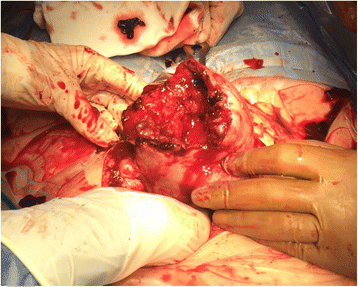Uterine rupture in a primigravid patient, an uncommon but severe obstetrical event: a case report
- PMID: 29208037
- PMCID: PMC5718063
- DOI: 10.1186/s13256-017-1507-9
Uterine rupture in a primigravid patient, an uncommon but severe obstetrical event: a case report
Abstract
Background: A spontaneous rupture of the unscarred uterus in a primigravid patient is extremely rare and is associated with high perinatal and maternal morbidity and mortality.
Case presentation: A 34-year-old white primigravid woman, 31 + 3 weeks of gestation, presented with pre-eclampsia and developed a sudden acute abdomen. An emergency laparotomy was performed and a uterine rupture was found as the cause of the event. A stillborn girl was born.
Conclusion: A rupture of the pregnant uterus should always be considered in a pregnant woman presenting with abdominal pain, even in a primigravid patient.
Keywords: Acute abdomen; Primigravid; Unscarred uterus; Uterine rupture.
Conflict of interest statement
Ethics approval and consent to participate
Not applicable.
Consent for publication
Written informed consent was obtained from the patient for publication of this case report and any accompanying images. A copy of the written consent is available for review by the Editor-in-Chief of this journal.
Competing interests
The authors declare that they have no competing interests.
Publisher’s Note
Springer Nature remains neutral with regard to jurisdictional claims in published maps and institutional affiliations.
References
Publication types
MeSH terms
Substances
LinkOut - more resources
Full Text Sources
Other Literature Sources
Medical


